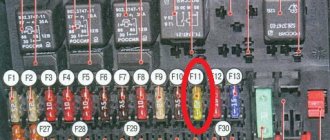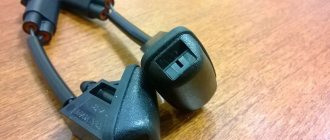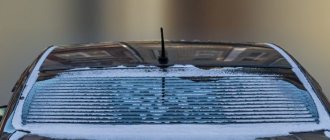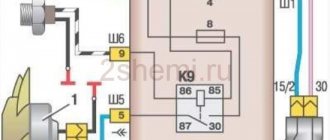Sometimes car enthusiasts are faced with the fact that the VAZ 2114 washer does not work. This seemingly harmless problem can actually lead to very serious consequences. After all, the washer is designed to clean the windshield from dirt and various debris that gets on it, which is sometimes impossible to remove with the help of wipers alone.
Such pollution significantly impairs visibility through the windshield, and this, in turn, can make driving on the road unsafe.
Washer VAZ 2114
It should be remembered that according to the law, driving a car whose washer has failed is strictly prohibited. It will also not be possible to pass a technical inspection with a faulty washer.
The washer itself is quite simple, and its most important components are:
- tank;
- pump with motor;
- hose;
- nozzles;
- washer fluid level sensor.
Window washer diagram for VAZ 2114
We’ll tell you below why breakdowns happen even in such a simple unit and how to fix them yourself.
Why doesn't the windshield washer work? TOP 8 popular reasons!
Greetings to everyone on the VAZ Repair website. Today we’ll talk about windshield washer. Let's figure out why the glass washer does not work, for what reasons it fails, and also how to prevent its breakdown in the future.
The windshield washer, in my opinion, needs no introduction. Every motorist knows what it is and what it is intended for. The benefits of this simple and at the same time effective device can hardly be overestimated; in the summer it allows you to quickly and easily refresh your “forehead” from dust and insects. With the arrival of cold weather, two presses of the button are enough to remove dirt from the windshield, and in winter the washer allows you to quickly melt the ice and clear the windshield of ice crust.
The washer works in tandem with the wipers, which also depend on this device to clean the glass. Working “dry”, wiper blades are ineffective; moreover, they wear out quickly and often damage the windshield itself.
Considering all of the above, we can draw the logical conclusion that a lot depends on the proper operation of the washer, so at the first sign of its malfunction, urgent measures should be taken.
Electrical damage
Another answer to the question - why the windshield washer does not work on the VAZ 2114, there may be damage to one or more elements of the electrical circuit of this device. They happen somewhat less frequently, but eliminating them can require significantly more effort.
The main electrical damages are:
- Fuse failure.
- Pump fault.
- A break in the electrical network.
- Faulty steering column switch.
The first reason can be solved simply - you just need to check fuse F7 in the common block and, if it is faulty, replace it with a new one.
VAZ 2114 fuse box
If the fuse turns out to be serviceable, then the pump itself should be checked for functionality. To do this, connect it directly to the battery. If the pump motor turns on and the unit itself begins to pump water, then the cause of the malfunction lies somewhere else. If the windshield washer motor of the VAZ 2114 does not work (which can be indicated by complete silence when connecting it to the battery), then the pump should be replaced with a new one.
If it turns out that the fuse and the pump are working, then you should check the electrical system itself. This is best done by “dialing” with a multimeter (tester). If a break is found, the wire will need to be replaced.
Understeering's shifter
The final electrical cause of possible windshield wiper system failure is a damaged steering column switch. You can check this by directly connecting its contacts: 53ah to W or 53ah to 53H. If after this procedure the windshield washer works, then the switch is working. If not, it should be replaced with a new one.
So why isn't the washer working? Common Causes
- Washer fluid level. In this case, everything is quite simple, we check the level of washer fluid in the tank, and then add it to the level if it is low, or continue to look for the problem.
- The washer was frozen. With the arrival of cold weather, many people forget to replace the washer fluid, as a result of which it simply freezes in the tank. As a result, when you try to clean the windshield, nothing happens, the engine hums, and no fluid flows. In this situation, all the blame falls on you, since you did not timely replace the summer fluid with the winter one. You can correct the situation by heating it, or by adding 200 grams of alcohol or a special defroster to the tank.
- Hoses. Damage to the fluid supply hoses or a simple hose slipping off the fitting may result in the washer not being supplied when pressed. You can check what's wrong by looking under the hood or driving into the inspection hole. If the hose is damaged it should be replaced, I guess that makes sense!?
- Injectors. No, we are not talking about fuel injectors, but about those that spray washer onto the glass. Sometimes the washer nozzles become clogged or freeze, after which the operation of the system may be disrupted. It is quite simple to check whether the injectors are to blame for the fact that the glass washer does not work. We remove the supply hose from the washer nozzle fitting, then activate the washer and see if the fluid is supplied. If fluid flows through the hose, the injectors are most likely clogged. The “forces” become clogged with dirt, sand, rust, ice, and anything else. The solution to the problem is the following - either wash them or replace them.
- Fuse. Sometimes the washer motor does not work due to a blown fuse. In this case, your task is to find the appropriate fuse and check its integrity. We replace the failed fuse and check the operation of the washer.
- Wiring, terminals and contacts. Sometimes the washer motor (pump) does not work due to poor contact or a broken circuit. For example, the wiring may be damaged or the terminals of the motor itself may rust or oxidize, making it impossible to supply washer.
- Switch. It is rare, but it still happens that the glass washer does not work precisely due to the fault of the button (switch) itself that activates the device. A multimeter or an electrician will help you understand what’s going on; we connect the electrodes and “call” the wiring and the button itself.
- Motor (pump). If you do not hear any sound when you press the button, the washer pump may be faulty. This conclusion can only be made after you have ruled out all of the above options. The pump is checked using a multimeter or tester; for convenience, it is advisable to dismantle the device.
To prevent breakdowns, monitor the level and condition of the washer fluid in the future, and avoid oxidation of the terminals, as well as voltage surges in the vehicle’s on-board network. Change your summer washer fluid to an anti-freeze one in a timely manner, and choose only high-quality liquids, this is the only way you can avoid problems with the washer.
That's all for me. Write what malfunctions of the washer are known to you, as well as how you managed to detect the breakdown. Now you know the most common reasons why the windshield washer does not work, and if necessary, you will be able to independently determine the malfunction, as well as take measures to eliminate it.
Electrical reasons why the VAZ 2114 windshield washer does not work.
Reason 1 - the fuse has blown, opening the power supply circuit to the washer pump.
Signs of this particular problem may be a malfunction of the cigarette lighter and the car's heater fan.
Exit: open the fuse box and replace fuse F7.
Reason 2 - the washer pump is faulty due to a burnt-out electric motor or oxidized contacts on the supply wires.
Solution to the problem: repairing the electric motor or cleaning the contacts from oxides.
Reason 3 – there is no current at the pump terminals.
This can be determined using a simple light bulb. Connect it to the wires powering the pump. If there is power, when you press the windshield washer lever, the light should light up. The reason for the lack of power may be a break in the line.
Solution to the issue: ring the line and determine the location of the breakthrough.
Reason 4 – the steering column wiper switch is faulty.
This can be checked by closing contacts 53ah and W or 53ah and 53H.
Solution to the problem: replace the switch with a new one or a used one in excellent condition.
Design of the washer on the “nine”
The diagnostic procedure is perceived as more accessible if you are familiar with the design of the module. And here it is, almost like on the Lada Vesta - it consists of simple elements:
- tank;
- 2 motors (rear and front);
- pipelines;
- 3 injectors (two on the front of the hood, one on the rear);
- wiring.
This concept has become widespread on new hatchbacks. Carburetor versions have a different layout. One motor and two electromagnetic valves (EMVs) are installed there, distributing, respectively, to two channels.
Why the rear and windshield washer does not work on the VAZ 2109: possible reasons
A trivial reason for claiming a malfunction may be the lack of washer fluid in the tank. At the same time, the motor hums, and the emulsion is not supplied from the sprayers. You can't call it a breakdown.
There is water in the container, but it does not splash. This set of circumstances is less pleasant - perhaps one of the electrical components has failed. There's no point in getting lost. It's better to look for slot F7 in the fuse block. The two-contact plate inserted into it must be intact. If damaged, then the part must be replaced.
It is quite possible that the problem is not the fuse at all. The machines of the ninth family are far from new, so there may be problems with any of the electrical network nodes:
- motor;
- solenoid valves;
- Understeering's shifter;
- wiring.
If the standard windshield washer does not work on a VAZ 2109, and water splashes from the nozzle at the rear, then most likely the front solenoid valve is closed. The essence of the diagnosis: we swap the functional purpose of the valve devices. To do this, switch the power terminals from the rear EMC to the front. If the problem really is a faulty damper, then now the liquid will spray onto the front glass, and there will be silence from behind. The solution is obvious - change.
The steering column switch, although a durable unit, is not immune to damage. You can check the unit in one invoice. By pressing “towards yourself,” the plus is applied to the motor and valve. Then it’s a matter of technique - the assistant holds the lever, and the performer under the hood uses a multimeter to measure the voltage between the positive wire and ground: it should be 12 Volts.
If the device shows 0 V, there is no need to rush to dispose of the steering column paddle. You should evaluate the performance of the wire going from the switch to the motor and valves. We connect the ends with a tester and look at the resistance. A zero value in Ohms indicates wiring integrity.
Electrical appliances may work properly, but water will not spray out. This is a reason to inspect the injectors - perhaps they are clogged.
Design and principle of operation of the glass washer
You can get a good stain on a window not only when it’s damp and dirty outside, but even when it’s warm and sunny and the weather doesn’t foretell any trouble. At such moments, you may even need to urgently stop to clean the windshield, and perhaps the rear window, to ensure better visibility.
So, the washer is designed so that in any weather a stream of water can wet the window, thanks to which the wiper blades can easily remove dirt. If you do this without first cleaning the glass, then there is a risk of damaging it with scratches. And this, as you know, will not help anyone.
Diagram of the wind window cleaning device
The washer mechanism consists of several main parts on which the operation depends:
- tank;
- pump;
- windshield washer tube;
- windshield washer check valve;
- injectors.
The tank, as the name suggests, contains water for washing. The pump and nozzles supply water to the glass. Some cars, as mentioned above, have the ability to install a rear window washer with fan nozzles. A fan jet will help protect not only the front window, but also the rear window from bad weather.
The pump also consists of several parts:
The windshield washer check valve is designed to allow water to flow to the nozzles. Then water will instantly flow to the window when the pump is running. This part adapts to the device, but is not required for installation. The scheme will work without it.
Car windshield
We treat and improve
Surely all owners know that even a fully functional system produces little pressure. The reason for this is the low power of the standard motor. If the windshield washer does not work on a VAZ 2109, you can eliminate the cause and at the same time tune the system by installing a pump from:
To be completely sure, you can install:
- fan injectors (for example, from Volvo S80);
- a check valve that prevents fluid from draining from the rear injector line;
- filter to prevent clogging of nozzles.
Mechanical breakdowns
The most common reasons why the VAZ 2114 windshield washer does not work are mechanical damage.
The most common of them are:
- the washer fluid has run out in the tank;
- the pipeline leading to the windshield wiper is clogged;
- the windshield wiper nozzles are clogged;
- the water used as washer fluid froze;
- the hose fell off the pump;
- the hose going to the windshield wiper is pinched;
- The supply hose has ruptured.
Repair of glass washer VAZ 2114
Problems related to washer fluid can be solved almost instantly - if it runs out, it should be topped up; if it is frozen, take the expansion tank to a warm room, warm it up, then drain the water or liquid that is inappropriate for the season and fill it with non-freezing one.
If the hose becomes clogged, it should be cleaned (blown out) and then replaced. If the nozzles are clogged, they should also be carefully cleaned using a very thin needle. This operation should be done carefully, without unnecessary effort.
According to the recommendations of car manufacturers, washer fluid should be poured into the expansion tank through a special filter mesh, which will protect the hose and nozzles from possible clogging.
Sometimes it happens that during operation the hose becomes kinked, pinched, or even falls off the expansion tank. In such a situation, it is enough to straighten the hose and install it in its original place. If the hose ruptures (for example, when the coolant freezes), a new one should be installed instead.
Let's sum it up
The washer sprayer on a VAZ 2109 may not work for many reasons:
- there is no liquid in the tank;
- the motor is broken;
- solenoid valve stuck;
- fuse F7 burned out;
- the steering column switch is broken;
- the wire is broken;
- the injectors are clogged.
All faults are diagnosed by elimination. In some cases, a multimeter is used.
The system is upgraded by installing a high-performance pump, check valve and filter. A common tuning procedure is the installation of two motors and removal of the EMC valves.
Video “Check Valve Operation”
You can learn how the washer system valve works from the video from the author Roman Romanov.
Rear “wiper” - the rear window cleaner is located on the rear door of VAZ 2108, 2109 cars. It consists of a gear motor, a lever and a brush (“wiper”). The rear window washer consists of an electric motor in the washer fluid reservoir, an electromagnetic valve for turning on the rear window washer, pipes through which washer fluid is supplied and a nozzle above the rear door.
Connection diagram for the rear window cleaner and washer (rear wiper) of VAZ 2108, 21081, 21083, 2109, 21091, 21093 vehicles produced before 1998 with mounting block 2114 and a “high” instrument panel
Features of electrical circuits for turning on the rear window cleaner and washer (rear wiper)
— Electric current enters the system for turning on the cleaner and washer from terminal “30” of the generator, when contacts “30” and “15/2” of the ignition switch are closed.
— The steering column switch (right, terminal “53ah”) receives current from the ignition switch, through fuse No. 4 (F7) and block Ш3 (Х3) of the mounting block.
— When contacts “53ah” and “53H” of the steering column switch are closed, the wiper motor on the rear door of the car is turned on; when contacts “53ah” and “WH” are closed, the rear window washer is turned on.
Causes of washer malfunction
If the windshield washer does not work, it will not be difficult for an experienced driver to identify the cause of such a malfunction, and even a beginner, after familiarizing himself with the main failures in the cleaning system, will be able to eliminate them on his own.
Mechanical problems
The most important reason, as mentioned above, may be the lack of washer fluid; in this case, you just need to top it up. If it is present, but does not splash in the winter, then perhaps it is simply frozen. In this case, the problem can be solved in one of two ways:
- warming up the engine;
- bringing the car into a warm garage.
After the liquid has thawed, the system will begin to operate as usual, but it is better to drain the water from the tank after this and replace it with an “anti-freeze” one.
Other significant mechanical reasons why the windshield washer does not spray include the following factors.
- Clogged injectors . Their exit can be blocked by various debris: rust, dirt or small particles. To check the correctness of the guess, you need to stop the supply of working fluid to the nozzles; if this is the case, then the supply of “anti-freeze” will be normal. The solution to this problem lies in replacing the nozzles.
- Disconnecting the hose . It may simply fly off while driving on bumpy roads, and then the fluid supply will continue, but the headlight and windshield washer nozzle will remain dry. Sometimes this happens in cars in which the connecting fittings are located on the hood, then when it is closed, the hoses are squeezed. In any case, the deformed or torn tube must be replaced and returned to its place.
Electrical faults
After checking the fluid level, the cleanliness of the injectors and the hose leading to them, it may turn out that all this has nothing to do with it, then the issue is for the following reasons:
- Fuse blown . You will need to find the safety block and check the insert; it can be found using the attached diagram, which is usually printed on the cover or in the car’s operating instructions. After checking, if this is indeed the reason, then you need to replace the damaged part
- Motor failure . To establish the accuracy of your guess, you should connect a multimeter to the motor terminals and check the voltage when you turn on the washer. If the voltage indicator is normal, but the motor remains inoperative, then the problem lies with it. You can determine which motor has failed by elimination, by moving the pump terminals from the windshield to its rear counterpart.
- Washer switch malfunction . It is usually located on the steering wheel. If, after checking the voltage, it is missing, and replacing the motor with a new unit did not help, then it turns out that the windshield washer switch or relay is not working. Only an experienced auto electrician can accurately diagnose a breakdown.
- Oxidation of pump terminals . During operation, they can not only oxidize, but also completely fall off, which is why the motor stops pumping liquid. To return everything to working condition, you need to clean the oxidized terminals or replace them with new ones.
Mechanical reasons for the malfunction of the windshield washer of the VAZ 2114.
Reason 1: sand or dirt gets in, and, as a result, the windshield wiper pipe becomes clogged.
Solution: remove and blow out the washer fluid pipes. Note that for preventive purposes, it is important to fill the washer fluid into the tank through a special mesh filter; this will protect both the fluid from getting contaminants into it at the time of filling, and the pump from the possibility of jamming.
Reason 2 - the tank has run out of windshield washer fluid.
The solution to the problem is very simple - just pour washer fluid or water into the tank (note that at sub-zero temperatures plain water cannot be used).
Reason 3 - clogged windshield wiper nozzles (nozzles).
Solution to the issue: cleaning the holes of the windshield wiper nozzles using a thin needle.
Reason 4 – the washer fluid has frozen.
If liquid that is inappropriate for weather conditions is poured into the tank, it may freeze in the pipes and the tank itself. If there are no special heaters, then you need to put the car in a warm garage and thereby solve this problem (the liquid will freeze), more details.
Reason 5 - rupture of the pressure main pipeline.
It can occur if the nozzles are clogged with debris or small stones, since such circumstances can lead to the formation of excess pressure inside the system, which, in turn, leads to rupture.
Solution to the problem: find the rupture and repair it - replacing part of the worn pipeline using special conductors.
Reason 6 - the hose has come off the feed pump.
Solution: installing a hose on the pump and then tightening it with a clamp.
Reason 7 – a crushed hose supplying washer fluid to the injectors.
Solution to the issue: Most often this happens due to the incorrect transition of the hose on the hood to the windshield wiper nozzles. Find the location of the bend and eliminate it.
Do-it-yourself troubleshooting
The main reasons for the lack of washer fluid can be eliminated with your own hands.
Cleaning the injectors
Their replacement and cleaning occurs in the same way and it begins with the removal of these parts, the process is as follows:
- open the hood;
- make sure that they have plastic plugs; if they are present, they must be carefully removed;
- take a flat-head screwdriver and open their spring fasteners to remove the injectors.
conclusions
If the rear or windshield washer fails, any problem can be quickly resolved, the main thing is to find the cause of the malfunction. In case of problems with nozzles and their complete replacement, it is better to choose these fan-type parts; they wet the glass better. Problems with the integrity or partial deformation of connecting tubes are best solved by connecting new cords. To avoid the listed problems with the washer system, you should use non-chlorinated water in warm weather, and “anti-freeze” water in cold weather.
The windshield washer of the VAZ 2107 does not work
Cars have special equipment for travel during bad weather associated with precipitation. The windshield of the VAZ 2107 is cleaned of water using movable brushes, and in case of contamination, the washer is activated. This device sprays a special liquid, it works simultaneously with the windshield wipers and removes dirt.
The equipment thus provides the necessary visibility for the driver and passengers. This device includes the following elements:
- Liquid reservoir.
- A pump that runs from the on-board network.
- Nozzles that blow a water jet onto the windshield of a car.
- Tubes connecting the tank to the actuators.
At the end of the summer season, the water in the system is replaced with non-freezing liquid, which will allow the system to be used in winter.
We find out why the VAZ 2114 windshield washer does not work
Sometimes car enthusiasts are faced with the fact that the VAZ 2114 washer does not work. This seemingly harmless problem can actually lead to very serious consequences. After all, the washer is designed to clean the windshield from dirt and various debris that gets on it, which is sometimes impossible to remove with the help of wipers alone.
Such pollution significantly impairs visibility through the windshield, and this, in turn, can make driving on the road unsafe.
It should be remembered that according to the law, driving a car whose washer has failed is strictly prohibited. It will also not be possible to pass a technical inspection with a faulty washer.
The washer itself is quite simple, and its most important components are:
- tank;
- pump with motor;
- hose;
- nozzles;
- washer fluid level sensor.
We’ll tell you below why breakdowns happen even in such a simple unit and how to fix them yourself.
Main causes of failures of additional equipment
If the washer on the car does not work, it is necessary to diagnose it using simple techniques. This system may fail for a number of reasons, which are listed below:
- breakdown of the injection pump;
- fuse blown;
- kinking or squeezing of the supply hose;
- breakdown of the steering column switch;
- freezing of water in pipelines or other devices;
- loss of contact in the electrical network.
It is possible to determine the cause of the malfunction and the amount of costs to restore the system's functionality based on the results of a careful inspection. If you need to replace individual parts or elements, you can do it yourself. The device that blows the windshield to clean it from fresh or dried dirt does not work.
Most likely, you will need to replace failed equipment.
Auto-assistance
When, after turning on the VAZ-2115 washer, not a drop of water or “anti-freeze” gets through the nozzles onto the windshield of the car, then the driver’s first assumption will be that it simply is not in the nutrient tank, it has already been used up. Then you will have to open the hood and check this assumption. It is indeed possible that the liquid in the nutrient tank has run out, and after refilling it, the washer, as if nothing had happened, began to work properly.
But the second option is also possible. There really is no water in the nutrient tank, not because it was used up, but because it simply flowed out of there. This happens as a result of the fact that the end of the hose suitable for the tank flies off the fitting. And since the fitting is located in the lower part of the tank, the liquid level begins to gradually decrease until almost all of it flows out of there.
On VAZ-2115 cars with a fairly long mileage, another mechanical malfunction may occur due to a rupture of the fluid supply hose to the injectors in the area of its movable bend, which occurs when the hood is opened and closed. The hose breaks due to the fact that over time, the material from which it is made becomes more rigid and if you have to open the hood in severe frost, it simply breaks.
Another mechanical problem involves the washer pump, which stops working as a result of its drive shaft shearing. This happens if there was water in the nutrient tank that froze due to the temperature dropping below zero degrees. Therefore, it becomes impossible to turn the pump blades, and if the driver turns on the washer, then when the electric motor armature tries to turn, the pump drive shaft can be cut off.
Electrical malfunctions leading to failure of the washer may include the blown fuse F7 (30A), located in the mounting block. Considering that it protects several electrical circuits, the reason for its burnout may not necessarily be the washer circuit.
Under the steering switch, the washer motor is activated via relay K3, which also does not last forever and can fail. Therefore, when troubleshooting the washer electrical circuit, it is necessary to sequentially check all of the above devices.
Share this article with your friends:
System diagnostics
A working washer blows a jet of water onto the windshield glass, while at the same time the blade moves. You can determine which element needs replacement as follows:
- We start the engine and open the hood.
- We ask an assistant to pull the steering column switch lever towards you.
- If the pump is running, it will be clearly audible.
- There is no water jet blowing - this means that the nozzles are clogged.
If the liquid in the tank is frozen and needs to be replaced, then such a malfunction is difficult to miss.
Troubleshooting equipment
A failed washer that does not blow the windshield with a special liquid is restored. Most often, the injection pump needs to be replaced, which occurs in the following sequence:
- The contact group is removed from the device.
- Using a short screwdriver, remove the compressor from the hole.
- In its place we insert a new unit into the tank.
- We put connectors on the contact group, after which you can perform the test.
The engine operates with a characteristic sound when functioning correctly. The glass is blown with a water jet from the nozzles. If the tubes are replaced, you will have to wait a little time for them to fill with liquid. Using this system as intended will allow you to drive in any weather.











